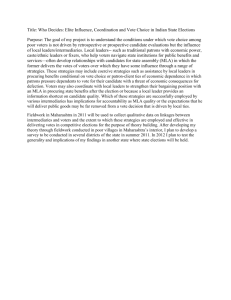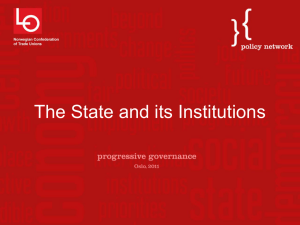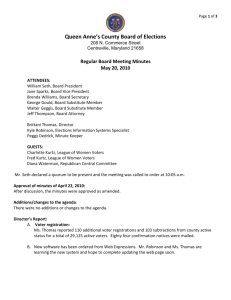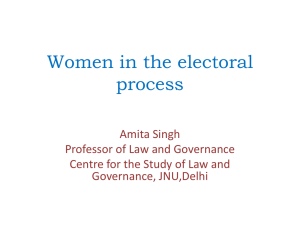Profile of Philippine Voters - Philippine Statistics Authority
advertisement
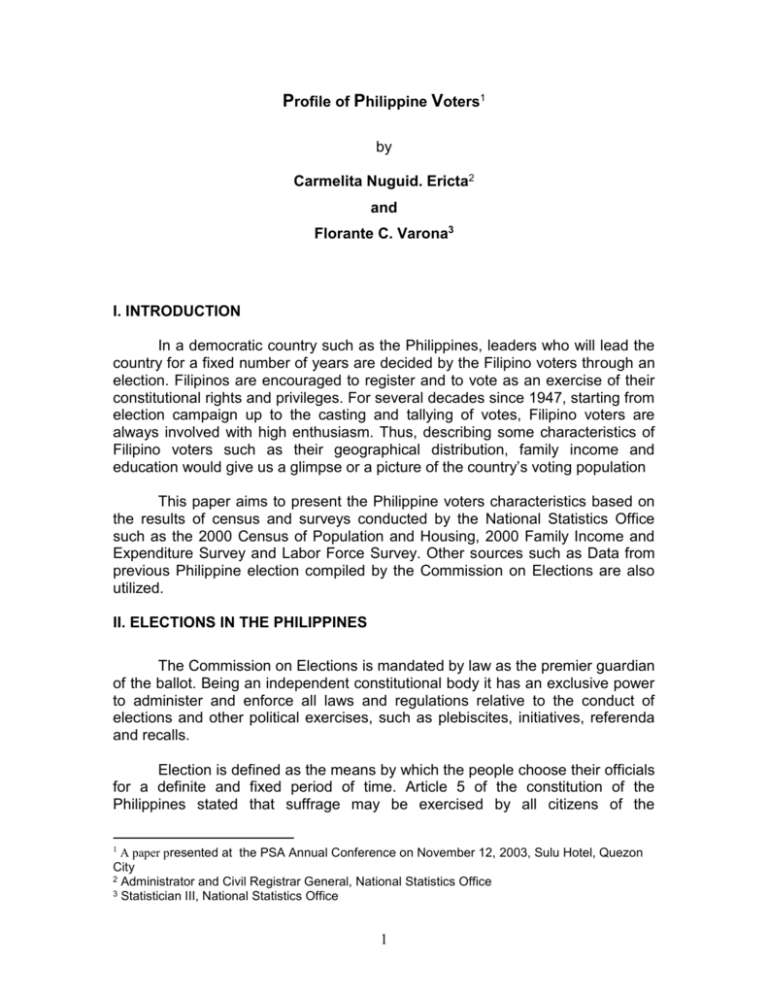
Profile of Philippine Voters1 by Carmelita Nuguid. Ericta2 and Florante C. Varona3 I. INTRODUCTION In a democratic country such as the Philippines, leaders who will lead the country for a fixed number of years are decided by the Filipino voters through an election. Filipinos are encouraged to register and to vote as an exercise of their constitutional rights and privileges. For several decades since 1947, starting from election campaign up to the casting and tallying of votes, Filipino voters are always involved with high enthusiasm. Thus, describing some characteristics of Filipino voters such as their geographical distribution, family income and education would give us a glimpse or a picture of the country’s voting population This paper aims to present the Philippine voters characteristics based on the results of census and surveys conducted by the National Statistics Office such as the 2000 Census of Population and Housing, 2000 Family Income and Expenditure Survey and Labor Force Survey. Other sources such as Data from previous Philippine election compiled by the Commission on Elections are also utilized. II. ELECTIONS IN THE PHILIPPINES The Commission on Elections is mandated by law as the premier guardian of the ballot. Being an independent constitutional body it has an exclusive power to administer and enforce all laws and regulations relative to the conduct of elections and other political exercises, such as plebiscites, initiatives, referenda and recalls. Election is defined as the means by which the people choose their officials for a definite and fixed period of time. Article 5 of the constitution of the Philippines stated that suffrage may be exercised by all citizens of the 1 A paper presented at the PSA Annual Conference on November 12, 2003, Sulu Hotel, Quezon City 2 Administrator and Civil Registrar General, National Statistics Office 3 Statistician III, National Statistics Office 1 Philippines, not otherwise disqualified by law, who are at least 18 years of age and who shall have resided in the Philippines for at least one year and in the place wherein they propose to vote, for at least six months immediately preceding the election. No literacy, property, or other substantive requirement shall be imposed on the exercise of suffrage. The Omnibus Election code of the Philippines states on its general provision that it shall be the obligation of every citizen qualified to vote to register and cast his vote. Also, the Republic Act No. 8189 or “Voter’s Registration Act of 1996” cites that in order to be able to vote in any election, a qualified voter shall be registered in the permanent list of voters in a precinct of the city or municipality wherein he resides. However, persons disqualified from registering are not allowed to vote such as the following (1) those who have been sentenced by final judgment to suffer imprisonment of not less that one (1) year. (2) any person who has been adjudged by final judgment by a competent court or tribunal of having committed any crime involving disloyalty to the duly constituted government such as rebellion, sedition, violation of the firearms laws or any crime against national security and (3)Insane or incompetent persons declared as such by competent authority. For 2000, the country’s seven national prisons, registered a total population of 23,695 inmates or 0.05 percent of 43.3 million voting population. The Voter’s Absentee Voting Act of 2003 allows all qualified citizens of the Philippines abroad to vote for president, vice-president, senators and party-list representatives. However, those who lost their Filipino citizenship in accordance with Philippine laws and those who have expressly renounced their Philippine citizenship and who have pledged allegiance to a foreign country are not eligible to vote. Types of Elections In the Philippines, regular elections are held regularly over a period of time as mandated by the constitution. These are the following: 1. National Elections, for President and Vice-President of the Philippines shall be held every six years, and for Senators, every three years. 2. Local Elections, for Members of the House of Representatives, Party List Representatives and Provincial, City and Municipal Officials, every 3 years 3. Barangay Elections, every 3 years 4. ARMM Elections, for Regional Governor, Regional Vice-Governor, and Regional Assemblymen for the Autonomous Region in Muslim Mindanao (ARMM), every 3 years 5. Sangguniang Kabataan (SK) Elections, every 3 years, synchronized with the barangay elections 2 6. Plebiscite, Referendum, Initiative and Recall – these are not held on a regular basis. III. VOTING POPULATION Based on the 2000 Census of Population and Housing results (Table 1), the total population 18 years old and over numbered to 43.3 million persons. There were slightly more women (50.1 percent) than men (49.9 percent). Of the 16 regions in the Philippines, Region IV or Southern Tagalog had the biggest voter’s population, with 6.7 million persons accounting for 15.6 percent of the total. The National Capital Region (NCR) followed with 6.2 million persons or 15 percent. Central Luzon (Region 3) registered the third largest voter’s population with 4.7 million persons or 10.87 percent of the total. These three regions comprised 41.36 percent of the total population 18 years old and over. On the other hand, CAR had the least number of voters with only 764 thousand persons. Figure 1. Voters Population by Region :Philippines, 2000 8,000,000 6,737,224 7,000,000 6,000,000 Population 5,000,000 4,000,000 3,000,000 2,000,000 763,855 1,000,000 0 NCR CAR Region Region Region Region Region Region Region Region Region Region Region Region ARMM Caraga 1 2 3 4 5 6 7 8 9 10 11 12 Region 2004 Projected Voting Population For the coming 2004 election, the projected voting population is estimated at 49.25 million persons (please refer to table 3). This figure is about 60 percent of the projected 82.67 million Philippine population for 2004. Female voting population number a little more than the expected male voters with a sex ratio of 98.89 males for every 100 females. There are more male voters in the younger age groups 20 to 24 and 25 to 29 years old while female voters dominate the older age groupings 50 years old and over. 3 Figure 2. Projected Age-Sex Voting Population Pyramid, Philippines: 2004 A G E G R O U p 80 and over 75 to 79 70 to 74 65 to 69 60 to 64 55 to 59 50 to 54 45 to 49 40 to 44 35 to 39 30 to 34 25 to 29 20 to 24 18 to 19 10 Male 8 6 Female 2 4 0 2 4 6 8 Percent to Total Population Literacy and Education of Voters Of the 49 million projected voters for 2004, about two thirds (66%) or 33 million have completed some elementary or high school education; 15 percent are college undergraduates; and only 7 percent are college degree holders. In addition, there are about 1.6 million voters who have no education. Figure 3. Percent Distribution of Voters by Highest Educational Attainment: 2004 Post Baccalaureate 1% No grade completed 3% Academic Degree Holder 7% College Undergraduate 15% Elementary 34% Post Secondary 6% High School 32% 4 No grade completed Pre school Elementary High School Post Secondary College Undergraduate Academic Degree Holder Post Baccalaureate Not Reported 10 The projected voting population literacy rate was observed at 92 percent or 45.5 million literate voters out of 49.2 million voters for 2004. There is no significant difference between the literacy rate of women and that of men. Marital Status Of the 49.2 million projected voters for 2004, 60 percent or 29.4 million are legally married while voters with single marital status share 27 percent or 13.5 million of the total. Table A. Total Population 18 years and over by Marital Status and Sex: 2004 Marital Status Total Percent Male Percent Female Total 49,247,483 100.00 24,457,103 49.66 24,790,380 Single 13,538,332 27.49 7,449,405 55.02 6,088,927 Legally married 29,364,907 59.63 14,691,577 50.03 14,673,330 Widowed 2,657,992 5.40 642,821 24.18 2,015,171 Divorced/separated 624,509 1.27 226,243 36.23 398,266 Common-law/livein 2,665,392 5.41 1,364,539 51.19 1,300,853 Not reported 396,350 0.80 196,499 49.58 199,851 Figure 4. Projected Voting Population by Marital Status: 2004 35,000,000 29,364,907 30,000,000 Population 25,000,000 20,000,000 15,000,000 10,000,000 5,000,000 - le Sing lly m Lega d arrie wed Wido d arate d/sep rce Divo Marital Status 5 live-in -law/ mon Com own Unkn Percent 50.34 44.98 49.97 75.82 63.77 48.81 50.42 Employment As of April 2003, the voting population who were members of the labor force was estimated at 32.7 million. Of this, 61 percent or 19.9 million were males while the remaining 12.8 million were females. Employed male voters registered at 17.7 million were more in numbers than the 11.3 million female voters. This observation was also true for the employment rate posted at 89 percent for male as compared with the smaller 88.4 percent for females. Employment rate for the total voting population was computed at 88.8 percent. Of the 32.7 million voters in the labor force, 3.7 million were unemployed resulting to 11.2 percent unemployment rate. Higher occurrence of unemployed female voters was also noted in April 2003 having a larger 11.6 percent unemployment rate as compared to 11 percent unemployed male voters. Of the 29 million employed voters, 14 million or 48.4 percent were wage and salary workers, 11.5 million or 39.8 percent were own account workers and 3.4 million, unpaid workers. Around 4.1 million workers were employed as Agricultural, Forestry and Fishery Laborers. There were also about 3.6 million employed Field Crop Farmer voters. Domestic Helpers and Drivers combined for a total of 3.1 million voters Figure 5. Labor Force Summary of Voting Population, April 2003 Population 18 Years Old and Over 45,809,054 Not In the Labor Force In the Labor Force 13,087,486 (28.57%) 32,721,568 (71.43%) Employed Unemployed 29,042,924 (88.76%) 3,678,644 (11.24%) 6 Table B. Employed Voters by Type of Occupation in The Philippines: April 2003 Occupation All Occupations Agricultural, Forestry and Fishery Laborers Field Crop Farmers General Managers/ManagingProprietors Motor Vechicle Drivers Domestic Helpers and Cleaners and Related Workers Market Stall Vendors, Street Vendors and Related Workers Other Occupation Total 29,042,924 Percent 100.00 Male 17,745,496 Percent 100.00 Female 11,297,428 Percent 100.00 4,134,883 3,638,559 14.24 12.53 2,402,553 3,207,001 13.54 18.07 1,732,329 431,558 15.33 3.82 2,571,941 1,792,420 8.86 6.17 915,136 1,776,628 5.16 10.01 1,656,805 15,792 14.67 0.14 1,349,794 4.65 282,280 1.59 1,067,514 9.45 1,290,356 14,264,968 4.44 49.12 412,236 8,749,661 2.32 49.31 878,120 5,515,310 7.77 48.82 IV. HOUSEHOLDS HEADED BY VOTERS Of the 15 million households in the Philippines in year 2000, about 17 percent or 2.6 million households were headed by women voters while a bigger portion, 83 percent or 12.4 million of the total households were headed by male voters. Table C. Number of Household Heads by Sex : 2000 Number of Household Head Philippines Male Female Total 15,071,941 12,434,906 2,637,036 18 year old & over 15,067,302 12,432,193 2,635,110 Percent 99.97 82.49 17.48 Less than 18 years Old 4,639 2,713 1,926 Percent 0.03 0.02 0.01 There were 4,639 households headed by a person less than 18 years old. This number is equivalent to a small 0.03 percent of the total 15 million households in the Philippines. 7 Family Size The typical family of a Filipino voter had 5 members. The average size of a family headed by a Filipino voter ranged from 4.8 members in Cagayan Valley to 5.8 family members in ARMM Figure 6. Average Family Size in the Philippines by Region: 2000 7 5.8 Average Family Size 6 4.8 5 4 3 2 1 AG A M AR M C AR R AR C C C en tra N na lM in da an o ao o na in d M rn So u th or th e er n rn te N es da an M in in d M n er st W Ea ao s ya s Vi sa ya as ay C en tra rn te es lV is a io Vi s eg Lu lR W Bi co rn ut he So n n zo on uz lL tra en C ay ag C Ilo co s an R eg Va l io le y n 0 Region Family Income About 15 million families in the Philippines headed by a Filipino voter had an average annual family income of P145,151 in 2000. This amount can be translated to P32,381 per capita income or for each family member. Across regions, the highest annual family income was noted in National Capital Region estimated at P300,452, while the lowest family annual income of P79,590 was recorded in ARMM. 8 Table D. Number of Families, Average Annual Family Income, Average Annual Per Capita Income and Average Family Size of 18 year old and over household head by Region, 2000 Region Number of Families Average Family Income Average Per Capita Income Philippines 15,071,552 145,151 32,381 NCR 2,187,640 300,452 67,320 CAR 275,075 139,613 30,859 Ilocos 806,625 120,931 26,963 Cagayan Valley 566,692 108,427 25,875 Central Luzon 1,516,657 151,469 33,464 Southern Luzon 2,280,948 161,971 37,286 Bicol Region 899,207 95,299 20,619 Western Visayas 1,211,243 109,626 24,950 Central Visayas 1,102,783 99,601 21,752 Eastern Visayas 735,950 91,570 20,665 Western Mindanao 603,728 86,135 18,770 Northern Mindanao 535,446 110,328 23,927 Southern Mindanao 1,032,587 112,255 23,727 Central Mindanao 514,104 90,793 19,710 ARMM 394,255 79,590 14,817 CARAGA 408,613 81,504 18,461 Source : 2000 Family Income and Expenditures Survey, National Statistics Office Average Family Size 5.1 5.1 5.2 5.1 4.8 5.1 5.0 5.4 5.1 5.0 5.0 5.2 5.3 5.1 5.3 5.8 5.1 Housing Results from 2000 CPH observed that of the 15,278,808 housing units in the country, 15,264,250 housing units were identified to have at least an 18 year old or over household member. About 15 thousand houses had no Filipino voter among their occupants. Filipino voters preferred to live in single houses. This type of dwelling accounted for more than 87 percent or 13.3 million housing units. Multi-unit residential type ranked second with a little more than 1 million houses, while another 555 thousand housing units were duplex type. 9 Figure 7. Number of Housing with Voting Population : 2000 14,000,000 13,342,478 12,000,000 Number 10,000,000 8,000,000 6,000,000 4,000,000 2,000,000 1,092,383 554,874 0 Sin gle Dup ho u se lex Mul ti-u Com Inst Oth Not er h ituti Rep mer nit r o o orte n c usin al li ial/i esid d g v n i d enti ng q unit u s trial al uar /Ag t ers ricu ltura l Type of Housing Unit V. REGISTERED VOTERS 1995 Registration Rate On the average, there were about 214 voters for each precinct. At 37.7 million voting population in 1995 and 36.4 million registered voters, registration rate at the national level was a high 96.7 percent. Four regions showed more than a hundred percent registration rate. These were Region 3 (100.1 percent), Region 8 (105.9 percent), Region 9 (102.1 percent), and region 12 (103.3.0 percent). The highest registration rate was experienced in Region 8. 10 Figure 8. Registration Rate by Region, 1995 110.00 105.92 105.00 103.30 102.11 100.06 Percent 100.00 95.00 90.00 85.00 80.00 N.C.R. C.A.R. Region I Region Region Region Region Region Region Region Region Region Region Region II III IV V VI VII VIII IX X XI XII Region Source : Election and Barangay Affairs Department COMELEC 1995 Voter Turn-Out During the 1995 National Election, approximately 25.7 million (71 percent) of the 36.4 million registered voters actually voted. Across regions, the highest voter turn-out percentage was noted in Ilocos Region at 79 percent while the lowest was registered in the National Capital Region at 57 percent. Generally, there were more registered male voters than female. However, in the 1995 national election, more females had actually voted as compared with the males having a sex ratio of 98.96 males for every 100 females (Table 8-B). This voting pattern was also true for 6 regions, NCR, Central Luzon, Southern Tagalog, Bicol, Western Visayas and Central Visayas. 2002 Registration Rate Only 81.2 percent of the population 18 years old and over registered in July 15, 2002 Barangay Elections. The total number of registered voters was tallied at 37.9 million persons. Among the regions, Southern Tagalog emerged as the biggest in terms of number of registered voters with 5.7 million persons followed by National Capital Region having 5.3 million registered voters. On the other hand, CAR, comprising 669 thousand registered voters had the least number. 11 Six provinces reported having more than a million registered voters surpassing a million marks and these were: Cebu (1.71 million), Negros Occidental (1.25 million) Pangasinan (1.20 million), Bulacan (1.13 million), Cavite (1.06 million) and Laguna (1.01 million). National Capital Region, comprising 12 cities and 5 municipalities, had 5.3 million registered voters Notes on SK Voters The youth 15 to 17 years old were eligible to vote for Sangguninang Kabataan (SK). In 2000, SK voters’ regional distribution followed the same trend as compared to the population 18 years old and over. Of the 4.8 million 15-17 years old population, Southern Tagalog had the biggest share (14.7 percent). It was followed by National Capital Region (NCR) with 543 thousand SK voters. Central Luzon (Region 3) had the third largest SK population with 485 thousand or 10.02 percent of the total. The three regions comprised 35.95 percent of the total population 15-17 years old. CAR had the least number of voters with only 92 thousand persons. Figure 9. Philippine SK Voters Population by Region: 2000 800,000 712,926 700,000 600,000 Population 500,000 400,000 300,000 200,000 92,192 100,000 0 NCR CAR Region Region Region Region Region Region Region Region Region Region Region Region ARMM Caraga 1 2 3 4 5 6 7 8 9 10 11 12 Region The projected number of SK voters for 2004 is estimated to be 5.15 million persons. Female SK voters, numbering 2.64 million are slightly more than their male counterparts estimated at 2.51 million persons. 12 VI. CONCLUSION Although having known Filipino voters characteristics might not guarantee prediction of an election result nor would determine the discriminating factor that would infer the probable outcome of an election, descriptive results are still useful for those aspiring candidates who might want to utilize the data as added inputs for their election campaign strategy. Understanding the profile of more than 49 million voting population, its diversity and similarities across regions is a jumpstart towards future studies on learning the voting behavior of the Filipino people. REFERENCES National Statistics Office, 2000 Census of Population and Housing National Statistics Office, 2000 Family Income and Expenditure Survey datafile (fies2k.dta) National Statistics Office, April 2003 Labor Force Survey National Statistics Office, 1995 Population Projections Commission on Election Online. http://www.comelec.gov.ph 13 LIST OF TABLES Table 1. Population 18 Years Old and Over by Region : 2000 REGION Total Number Male Female Total Percent Male Female Philippines 43,331,229 21,619,285 21,711,944 100.00 49.89 50.11 NCR CAR Region 1 Region 2 Region 3 Region 4 Region 5 Region 6 Region 7 Region 8 Region 9 Region 10 Region 11 Region 12 ARMM Caraga 6,215,139 763,855 2,457,191 1,569,707 4,710,622 6,737,224 2,456,530 3,524,031 3,238,541 1,912,277 1,642,361 1,503,025 2,864,005 1,385,830 1,242,584 1,097,083 2,997,911 386,969 1,215,022 798,751 2,346,546 3,349,283 1,244,059 1,758,976 1,603,423 971,012 833,549 763,953 1,469,075 701,132 613,072 560,977 3,217,228 376,886 1,242,169 770,956 2,364,076 3,387,941 1,212,471 1,765,055 1,635,118 941,265 808,812 739,072 1,394,930 684,698 629,512 536,106 14.34 1.76 5.67 3.62 10.87 15.55 5.67 8.13 7.47 4.41 3.79 3.47 6.61 3.20 2.87 2.53 6.92 0.89 2.80 1.84 5.42 7.73 2.87 4.06 3.70 2.24 1.92 1.76 3.39 1.62 1.41 1.29 7.42 0.87 2.87 1.78 5.46 7.82 2.80 4.07 3.77 2.17 1.87 1.71 3.22 1.58 1.45 1.24 Source : 2000 Census of Population and Housing, National Statistics Office 14 Table 2. Population 15 - 17 Years Old by Region: 2000 Total Number Male Female Philippines 4,844,166 2,442,397 2,401,769 NCR CAR Region 1 Region 2 Region 3 Region 4 Region 5 Region 6 Region 7 Region 8 Region 9 Region 10 Region 11 Region 12 ARMM Caraga 543,259 92,192 270,133 184,089 485,179 712,926 305,837 418,254 362,347 231,229 203,100 180485 348,063 178,103 185,337 143,633 259,594 46,673 138,829 95,093 247,009 359,530 159,160 212,776 182,769 121,260 101,838 90751 173,613 88,678 91,198 73,626 283,665 45,519 131,304 88,996 238,170 353,396 146,677 205,478 179,578 109,969 101,262 89734 174,450 89,425 94,139 70,007 Region Percent Male Female 100.00 50.42 49.58 11.21 1.90 5.58 3.80 10.02 14.72 6.31 8.63 7.48 4.77 4.19 3.73 7.19 3.68 3.83 2.97 5.36 0.96 2.87 1.96 5.10 7.42 3.29 4.39 3.77 2.50 2.10 1.87 3.58 1.83 1.88 1.52 5.86 0.94 2.71 1.84 4.92 7.30 3.03 4.24 3.71 2.27 2.09 1.85 3.60 1.85 1.94 1.45 Total Source: 2000 Census of Population and Housing, National Statistics Office Table 3. Projected Voting Population by Age Group, Sex and Sex Ratio: Philippines, 2004 Age Group Philippines 18 to 19 20 to 24 25 to 29 30 to 34 35 to 39 40 to 44 45 to 49 50 to 54 55 to 59 60 to 64 65 to 69 70 to 74 75 to 79 80 and over Total Population Male Female Sex Ratio 49,247,483 24,457,103 24,790,380 98.89 3,349,937 7,740,004 6,949,594 6,159,749 5,389,105 4,617,073 3,880,515 3,153,855 2,514,067 1,906,995 1,416,836 988,991 647,172 533,590 1,663,106 3,904,396 3,481,087 3,071,837 2,688,220 2,310,249 1,941,965 1,576,407 1,245,726 929,772 677,568 459,140 286,546 221,084 1,686,830 3,835,608 3,468,507 3,087,912 2,700,885 2,306,824 1,938,550 1,577,448 1,268,341 977,223 739,268 529,851 360,626 312,506 98.59 101.79 100.36 99.48 99.53 100.15 100.18 99.93 98.22 95.14 91.65 86.65 79.46 70.75 Source : 1995 Population Projection, National Statistics Office 15 Table 4. Projected Population 18 Years Old and over by Highest Educational Attainment by Region: 2004 Highest Educational Attainment Total Percent Male Percent Female Percent Philippines 49,247,483 100.00 24,457,103 100.00 24,790,380 100.00 No Grade Completed Pre-school Elementary High School Post Secondary College Undergraduate Academic Degree Holder Post Baccalaureate Not Reported 1,575,892 58,485 16,902,142 15,878,576 2,902,359 3.20 0.12 34.32 32.24 5.89 716,273 27,344 8,649,769 7,978,704 1,499,339 2.93 0.11 35.37 32.62 6.13 860,100 31,153 8,250,518 7,899,196 1,402,600 3.47 0.13 33.28 31.86 5.66 7,210,696 14.64 3,536,451 14.46 3,674,567 14.82 3,279,488 305,157 1,121,891 6.66 0.62 2.28 1,376,090 126,855 539,944 5.63 0.52 2.21 1,905,228 178,481 582,071 7.69 0.72 2.35 Source: National Statistics Office Table 5. Projected Population 18 Years and Over by Literacy by Sex: 2004 Literacy Total Percent Male Percent Female Percent Total 49,247,483 100.00 24,457,103 49.66 24,790,380 50.34 Literate 45,500,402 92.39 22,677,383 49.84 22,823,019 50.16 Illiterate 3,747,081 7.61 1,860,519 49.65 1,886,561 50.35 Source: National Statistics Office Table 6. Labor Force Summary of Voting Population in the Philippines: April 2003 18 years old and Over Philippines Total Male Female Population 18 years Old and Over 45,809,054 22,771,986 23,037,068 In the Labor Force Population 32,721,568 19,938,228 12,783,339 Employed 29,042,924 17,745,496 11,297,428 Unemployed 3,678,644 2,192,732 1,485,911 Labor Force Participation Rate Employment Rate Unemployment Rate 71.43 88.76 11.24 Source: April 2003 Labor Force Survey, NSO 16 87.56 89.00 11.00 55.49 88.38 11.62 Table 7. Employed Voters by Class of Workers in the Philippines: April 2003 Number Percent Total Male Female Total Male Class or Workers Female Philippines 29,042,924 17,745,497 11,297,428 100.00 100.00 100.00 Wage and Salary Workers 14,050,384 Own Account Workers 11,552,946 Unpaid Family Workers 3,439,594 Source: April 2003 Labor Force Survey 8,758,082 7,526,759 1,460,656 5,292,302 4,026,188 1,978,938 48.38 39.78 11.84 49.35 42.42 8.23 46.85 35.64 17.52 Table 8-A. Number of Registered Voters by Region May 8, 1995 National and Local Elections, National Summary Region No. of Brgys. No. of Precincts Number of Registered Voters Average Number Total Per Precinct Philippines 41,920 169,863 36,415,154 214 N.C.R. C.A.R. Region I Region II Region III Region IV Region V Region VI Region VII Region VIII Region IX Region X Region XI Region XII 1,689 1,172 3,265 2,311 2,946 5,623 3,462 4,047 3,003 4,390 2,724 2,510 1,828 2,950 25,883 3,170 9,624 6,052 17,796 23,046 9,943 14,801 12,761 8,865 8,387 9,788 11,695 8,052 5,415,082 656,947 2,026,564 1,332,572 3,943,299 5,201,838 2,108,854 3,017,766 2,578,742 1,849,506 1,886,159 2,001,173 2,502,512 1,894,140 209 207 211 220 222 226 212 204 202 209 225 204 214 235 Source: Records and Statistics Division, COMELEC 17 Table 8-B. Number of Registered Voters by Sex, by Region May 8, 1995 National and Local Elections, National Summary Number of Registered Voters Region No. of Brgys. No. of Precincts Male Female Sex Ratio Philippines 41,920 169,863 18,292,150 18,122,994 100.93 N.C.R. C.A.R. Region I Region II Region III Region IV Region V Region VI Region VII Region VIII Region IX Region X Region XI Region XII 1,689 1,172 3,265 2,311 2,946 5,623 3,462 4,047 3,003 4,390 2,724 2,510 1,828 2,950 25,883 3,170 9,624 6,052 17,796 23,046 9,943 14,801 12,761 8,865 8,387 9,788 11,695 8,052 2,577,781 338,230 1,014,541 687,874 1,981,396 2,610,206 1,052,947 1,499,852 1,272,874 935,172 991,691 1,019,209 1,311,691 998,686 2,837,301 318,717 1,012,023 644,698 1,961,903 2,591,632 1,055,907 1,517,914 1,305,868 914,334 894,468 981,964 1,190,821 895,444 90.85 106.12 100.25 106.70 100.99 100.72 99.72 98.81 97.47 102.28 110.87 103.79 110.15 111.53 Source: Records and Statistics Division, COMELEC 18 Table 8-C. Number of Registered Voters Who Actually Voted, Percentage of Voting and Sex Ratio by Region May 8, 1995 National and Local Elections, National Summary Region Philippines Number of Voters Who Actually Voted Male Female Both Sexes 12,860,637 12,875,868 N.C.R. 1,453,843 1,612,769 C.A.R. 253,026 235,890 Region I 812,836 799,698 Region II 497,423 464,301 Region III 1,406,783 1,414,818 Region IV 1,844,856 1,867,498 Region V 799,444 820,272 Region VI 1,123,814 1,163,390 Region VII 962,559 1,006,353 Region VIII 700,677 699,856 Region IX 667,648 602,045 Region X 768,543 754,321 Region XI 867,574 804,746 Region XII 701,611 629,911 Source: Records and Statistics Division, COMELEC Percentage of Voting Female Both Sexes Male 25,736,505 70.31 71.05 70.68 3,066,612 488,916 1,612,534 961,724 2,821,601 3,712,354 1,619,716 2,287,204 1,968,912 1,400,533 1,269,693 1,522,864 1,672,320 1,331,522 56.40 74.81 80.12 72.31 71.00 70.68 75.92 74.93 75.62 74.92 67.32 75.41 66.14 70.25 56.84 74.01 79.02 72.02 72.11 72.06 77.68 76.64 77.06 76.54 67.31 76.82 67.58 70.35 56.63 74.42 79.57 72.17 71.55 71.37 76.81 75.79 76.35 75.72 67.32 76.10 66.83 70.30 Table 8-D. Number of Registered Voters Who Actually Voted and Percentage of Voting by Sex, by Region May 8, 1995 National and Local Elections, National Summary Number of Voters Who Actually Voted Region Philippines Male 12,860,637 Female Both Sexes 12,875,868 N.C.R. 1,453,843 1,612,769 C.A.R. 253,026 235,890 Region I 812,836 799,698 Region II 497,423 464,301 Region III 1,406,783 1,414,818 Region IV 1,844,856 1,867,498 Region V 799,444 820,272 Region VI 1,123,814 1,163,390 Region VII 962,559 1,006,353 Region VIII 700,677 699,856 Region IX 667,648 602,045 Region X 768,543 754,321 Region XI 867,574 804,746 Region XII 701,611 629,911 Source: Records and Statistics Division, COMELEC 19 Percentage of Voting Male Female Both Sexes 25,736,505 49.97 50.03 100.00 3,066,612 488,916 1,612,534 961,724 2,821,601 3,712,354 1,619,716 2,287,204 1,968,912 1,400,533 1,269,693 1,522,864 1,672,320 1,331,522 47.41 51.75 50.41 51.72 49.86 49.70 49.36 49.13 48.89 50.03 52.58 50.47 51.88 52.69 52.59 48.25 49.59 48.28 50.14 50.30 50.64 50.87 51.11 49.97 47.42 49.53 48.12 47.31 100.00 100.00 100.00 100.00 100.00 100.00 100.00 100.00 100.00 100.00 100.00 100.00 100.00 100.00 Table 9. Summary on the Number of Established Precincts, Grouped Precincts and Registered Voters For the July 15, 2002 Barangay Elections ( As of 04 July 2002 ) REGION / Total No. of Total No. of Total No. of PROVINCE / Established Clustered Registered CITY Precincts Precincts Voters PHILIPPINES 246,104 192,107 37,900,176 NCR 34,586 26,106 5,267,732 CAR 4,251 3,456 668,789 Abra 817 609 119,832 Apayao 300 254 47,761 1,561 1,353 255,964 Ifugao 528 397 78,856 Kalinga 584 467 93,064 Mt. Province 461 376 73,312 14,012 10,476 2,117,839 Ilocos Norte 1,978 1,365 276,273 Ilocos Sur 2,134 1,550 310,701 La Union 2,303 1,646 334,547 Pangasinan 7,597 5,915 1,196,318 REGION II 8,584 6,651 1,320,314 Benguet REGION I Batanes 54 41 8,198 Cagayan 2,928 2,258 443,574 Isabela 3,948 3,104 618,861 Nueva Vizcaya 1,176 867 174,668 478 381 75,013 26,262 20,600 4,074,911 Bataan 2,208 1,561 312,879 Bulacan 7,353 5,640 1,129,857 Nueva Ecija 5,207 4,543 895,657 Pampanga 5,869 4,670 896,506 Tarlac 3,290 2,558 510,533 Zambales 2,335 1,628 329,479 Quirino REGION III 20 REGION IV 36,462 28,843 5,733,920 580 442 87,728 Batangas 6,292 4,873 979,632 Cavite 6,547 5,220 1,056,015 Laguna 5,881 5,161 1,010,951 684 518 103,800 Occidental Mindoro 1,173 818 165,348 Oriental Mindoro 1,990 1,493 303,261 Palawan 2,147 1,745 345,522 Quezon 5,326 3,900 768,734 Rizal 5,032 4,021 782,958 810 652 129,971 13,986 10,938 2,172,446 Albay 3,308 2,712 532,905 Camarines Norte 1,425 984 197,801 Camarines Sur 4,617 3,303 670,658 Aurora Marinduque Romblon REGION V Catanduanes 727 578 111,199 Masbate 2,037 1,747 345,243 Sorsogon 1,872 1,614 314,640 20,230 15,621 3,112,311 Aklan 1,455 1,197 233,753 Antique 1,471 1,123 217,710 Capiz 2,198 1,764 351,751 397 355 68,708 Iloilo 6,536 5,113 990,123 Negros Occidental 8,173 6,069 1,250,266 17,663 14,515 2,853,122 Bohol 3,731 2,828 564,712 Cebu 10,098 8,785 1,706,970 3,518 2,643 532,102 316 259 49,338 12,427 9,866 1,899,183 REGION VI Guimaras REGION VII Negros Oriental Siquijor REGION VIII Biliran 491 380 76,043 Eastern Samar 1,304 1,051 200,817 Leyte 5,428 4,242 818,974 Northern Samar 1,645 1,293 251,843 Samar 2,317 1,908 359,194 Southern Leyte 1,242 992 192,312 21 REGION IX 8,594 7,317 1,409,456 Zamboanga del Norte 2,689 2,263 445,401 Zamboanga del Sur 4,211 3,600 681,179 Zamboanga Sibugay 1,477 1,256 243,695 217 198 39,181 11,618 9,216 1,761,701 3,103 2,547 481,734 Isabela City REGION X Bukidnon Camiguin 334 243 49,357 Lanao del Norte 2,392 1,936 379,312 Misamis Occidental 1,819 1,404 273,296 Misamis Oriental 3,970 3,086 578,002 11,551 8,941 1,777,054 Davao Oriental 1,356 1,074 215,879 Davao del Norte 2,321 1,720 337,995 Davao del Sur 6,148 4,817 959,634 Compostela Valley 1,726 1,330 263,546 9,617 7,504 1,485,373 North Cotabato 2,836 2,274 440,954 South Cotabato 3,421 2,545 512,065 Sarangani 1,166 919 183,225 Sultan Kudarat 1,685 1,367 271,332 Cotabato City 509 399 77,797 ARMM 9,369 6,663 1,191,549 Sulu 1,866 1,254 206,695 902 656 112,178 Lanao del Sur 2,869 1,956 324,163 Maguindanao 2,916 2,092 409,146 Basilan 816 705 139,367 CARAGA 6,892 5,394 1,054,476 Agusan del Norte 1,687 1,388 272,885 Agusan del Sur 1,616 1,274 248,171 Surigao del Norte 1,861 1,380 272,301 Surigao del Sur 1,728 1,352 261,119 REGION XI REGION XII Tawi-Tawi SOURCE: Election and Barangay Affairs Department (EBAD), COMELEC 22


